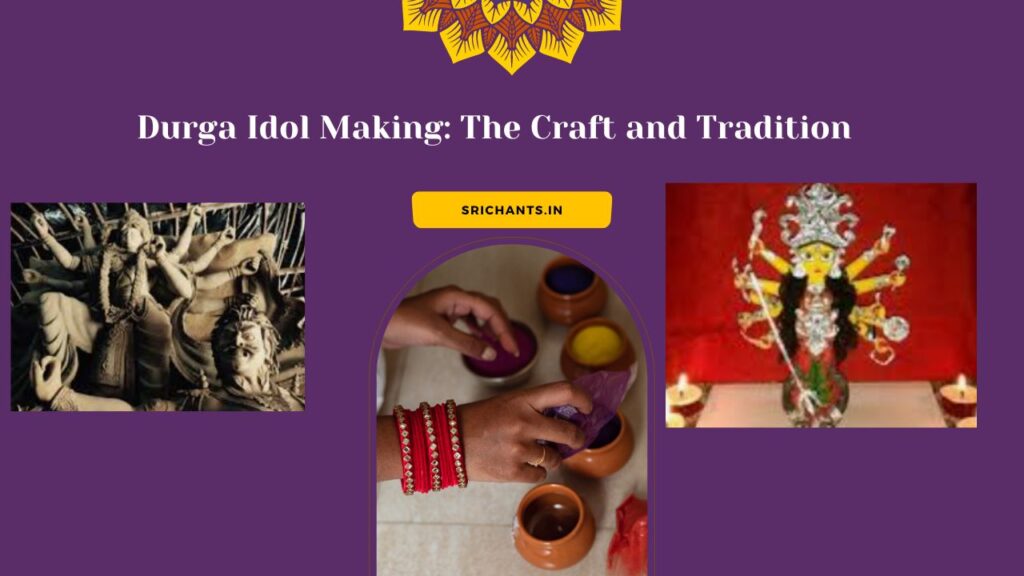Durga Idol Making : The Craft and Tradition
Introduction
Durga Puja, also referred to as Navaratri, is a significant and lively festival that commemorates the triumph of Goddess Durga over the buffalo deity Mahishasura. The intricate and awe-inspiring idols of Goddess Durga are one of the most captivating aspects of this festival. These idols are meticulously handcrafted by expert artisans and are a testament to the rich cultural heritage of Bengal. This article will investigate the craft and tradition of Durga Puja idol-making seminars, including the process, significance, and legends that are associated with this art form.
The Origins of Idol Making in Kumartuli
It is widely believed that the art of idol creation has its roots in Kumartuli, a town that translates to “Potter’s Locality.” Kumartuli, which is located in the northern region of Kolkata, has been the center of idol production for nearly three centuries. The handcrafted idols of Goddess Durga are produced by approximately 550 workshops that operate year-round in this vibrant neighborhood, which is home to approximately 150 potter families.
The clay utilized in the production of these idols is of great importance and is obtained from the margins of the Hooghly River. This clay, which is referred to as “Ganga Maati,” is renowned for its silky texture and is regarded as essential for the authenticity of the idols. The artisans of Kumartuli have been instrumental in the development of the art form and its inclusion in the Durga Puja festivities, thanks to their exceptional dedication and craftsmanship.
The Process of Idol Making
The production of a Durga Puja idol is a complex and time-consuming procedure that necessitates meticulous attention to detail. The idols are prepared well in advance of the festival by the artisans of Kumartuli, who commence their work between June and August. The procedure commences with the development of a bamboo framework that functions as the idol’s skeleton. This framework is subsequently covered with a mixture of wheat and clay, which provides it with structure and form.
The artisans combine fine jute fibers with the renowned Ganga Maati clay to produce a flawless finish. This mixture is meticulously applied to the dried framework, layer by layer, to produce the intricate features of the deity. As a result of their intricate detailing, the heads of the deities are sculpted separately and subsequently affixed to the body. The idols are permitted to dry in the sun for an extended period of time after the structure has been completed.
Symbolism and Significance
The Durga Puja idol is imbued with symbolic significance in every aspect. The idol is a representation of the goddess, who is depicted as a formidable warrior who is adorned with exquisite jewelry and attire. The primary idol of Goddess Durga is accompanied by her four offspring, Ganesha, Saraswati, Kartikeya, and Lakshmi, each of whom represents a distinct aspect of divinity. The goddess’s power and fearlessness are symbolized by the lion she rides on, while the buffalo demon king she defeated is venerated as a symbol of the triumph of good over evil.
During the festival, the deities are not merely artistic representations; they are regarded as living entities. On the auspicious day of Mahalaya, the goddess’s eyes are painted, which is preceded by a ceremony in honor of Lord Ganesha. It is believed that the idol is brought to life by painting its eyes, which infuses it with divine energy. The bursting of conch shells is a significant component of this ceremony, which signifies the goddess’s reawakening.
Legends and Traditions
The art form of idol making in Kumartuli is infused with legends and traditions that contribute to its profundity and distinctiveness. One intriguing tradition involves the combination of clay from the Hooghly River with dirt from a prostitute’s courtyard. This tradition is predicated on the notion that a man’s virtues are forfeited when he enters a brothel. The soil from the courtesan’s courtyard, which is referred to as “Punya Mitti,” is regarded as pristine and is collected by potters or priests for the idol-making process.
Although this tradition may appear to be contradictory, it embodies the paradoxical nature of society’s perception of purity and impurity. It functions as a reminder that divinity can be found in unexpected locations and that all individuals are deserving of respect and inclusion. This tradition also underscores the artisans’ aspiration to foster harmony and unity among various segments of society through their art.
Preservation of Tradition
The artisans of Kumartuli are exceedingly proud of their craftsmanship and endeavor to maintain the art form’s authenticity. In order to satisfy the expanding demand for Durga idols, numerous individuals establish transitory workshops in various regions of India. They maintain a connection to their roots by carrying the Ganga Maati clay, despite being removed from their hometown.
These artisans’ deities are not only works of art, but also a source of income for them. This tradition has been maintained for generations as a result of their dedication and passion for their craft. The idol-making enterprises in Kumartuli are not only a source of income but also a testament to the artistic prowess and cultural heritage of Bengal.
Conclusion
The Durga Puja idol-making enterprises in Kumartuli are a testament to the artistic talent and rich cultural heritage of Bengal. These deities are a visual delight during the festival due to their meticulous craftsmanship, adherence to traditions, and attention to detail. In Kumartuli, the craft of idol-making is not solely a profession; it is a labor of love and devotion. It symbolizes the preservation of ancient traditions, the unity of communities, and the celebration of the divine power of the deity Durga.
During Durga Puja, we are captivated by the mesmerizing deities. However, we must also recognize the artisans’ extraordinary skill and commitment to bringing these objects to life. Their artistry and devotion are instrumental in the preservation of this ancient tradition and the perpetuation of the Durga Puja spirit for future generations.








